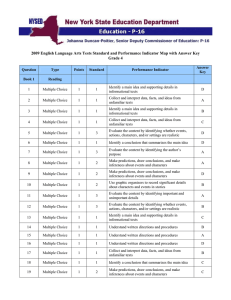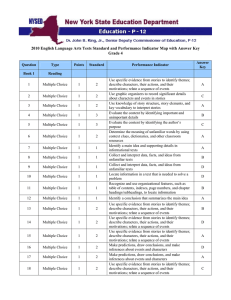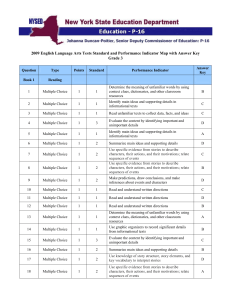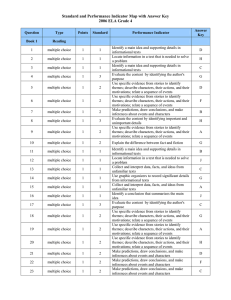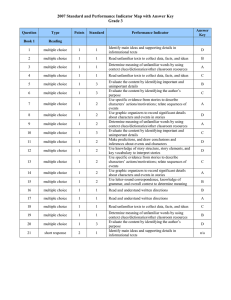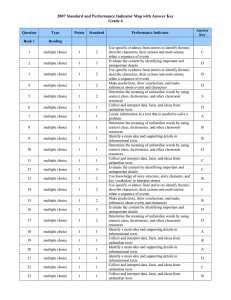2008 English Language Arts Tests Standard and Performance Indicator Map... Grade 4
advertisement
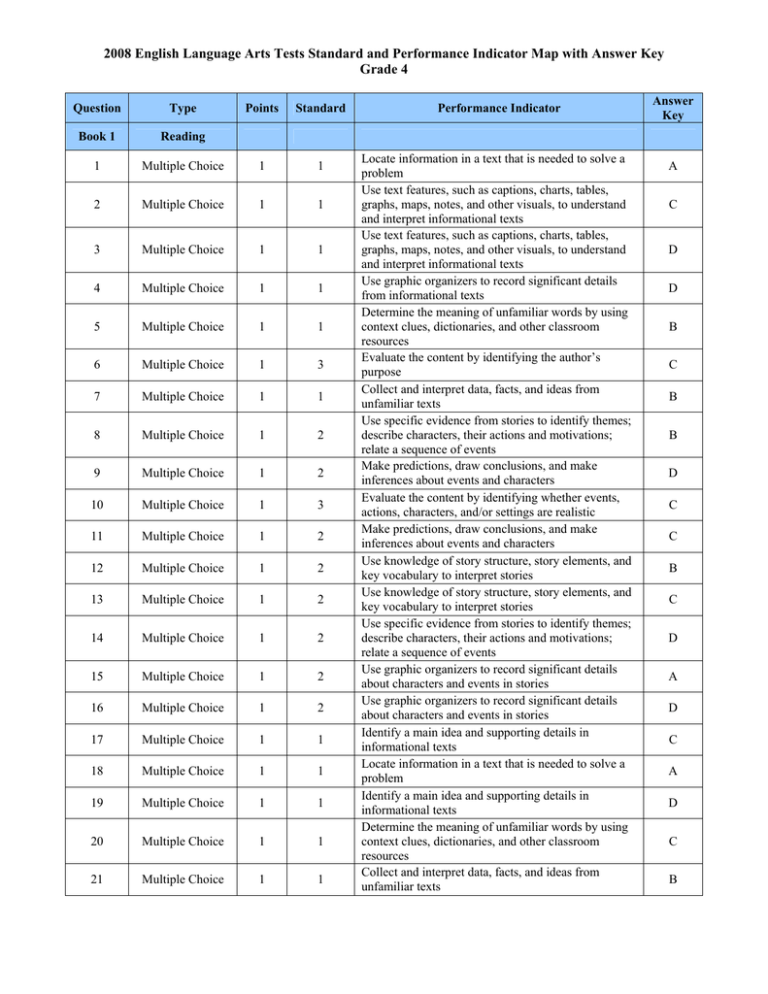
2008 English Language Arts Tests Standard and Performance Indicator Map with Answer Key Grade 4 Question Type Points Standard Book 1 Reading 1 Multiple Choice 1 1 2 Multiple Choice 1 1 3 Multiple Choice 1 1 4 Multiple Choice 1 1 5 Multiple Choice 1 1 6 Multiple Choice 1 3 7 Multiple Choice 1 1 8 Multiple Choice 1 2 9 Multiple Choice 1 2 10 Multiple Choice 1 3 11 Multiple Choice 1 2 12 Multiple Choice 1 2 13 Multiple Choice 1 2 14 Multiple Choice 1 2 15 Multiple Choice 1 2 16 Multiple Choice 1 2 17 Multiple Choice 1 1 18 Multiple Choice 1 1 19 Multiple Choice 1 1 20 Multiple Choice 1 1 21 Multiple Choice 1 1 Performance Indicator Locate information in a text that is needed to solve a problem Use text features, such as captions, charts, tables, graphs, maps, notes, and other visuals, to understand and interpret informational texts Use text features, such as captions, charts, tables, graphs, maps, notes, and other visuals, to understand and interpret informational texts Use graphic organizers to record significant details from informational texts Determine the meaning of unfamiliar words by using context clues, dictionaries, and other classroom resources Evaluate the content by identifying the author’s purpose Collect and interpret data, facts, and ideas from unfamiliar texts Use specific evidence from stories to identify themes; describe characters, their actions and motivations; relate a sequence of events Make predictions, draw conclusions, and make inferences about events and characters Evaluate the content by identifying whether events, actions, characters, and/or settings are realistic Make predictions, draw conclusions, and make inferences about events and characters Use knowledge of story structure, story elements, and key vocabulary to interpret stories Use knowledge of story structure, story elements, and key vocabulary to interpret stories Use specific evidence from stories to identify themes; describe characters, their actions and motivations; relate a sequence of events Use graphic organizers to record significant details about characters and events in stories Use graphic organizers to record significant details about characters and events in stories Identify a main idea and supporting details in informational texts Locate information in a text that is needed to solve a problem Identify a main idea and supporting details in informational texts Determine the meaning of unfamiliar words by using context clues, dictionaries, and other classroom resources Collect and interpret data, facts, and ideas from unfamiliar texts Answer Key A C D D B C B B D C C B C D A D C A D C B 2008 English Language Arts Tests Standard and Performance Indicator Map with Answer Key Grade 4 (continued) Question Type Book 1 Reading 22 Standard Multiple Choice 1 1 23 Multiple Choice 1 3 24 Multiple Choice 1 2 25 Multiple Choice 1 2 26 Multiple Choice 1 2 27 Multiple Choice 1 3 28 Multiple Choice 1 2 Explain the difference between fact and fiction C 4 2 Listening/Writing cluster n/a 4 3 Reading/Writing cluster n/a 3 n/a Writing Mechanics cluster n/a Book 2 29-31 Book 3 32-35 Listening and Writing Short and Extended Response Reading and Writing Short and Extended Response Book 2 & Book 3 Writing Mechanics 31 & 35 Extended Response Performance Indicator Answer Key Points Identify a conclusion that summarizes the main idea Evaluate the content by identifying the author’s purpose Use specific evidence from stories to identify themes; describe characters, their actions and motivations; relate a sequence of events Use specific evidence from stories to identify themes; describe characters, their actions and motivations; relate a sequence of events Use graphic organizers to record significant details about characters and events in stories Evaluate the content by identifying important and unimportant details C A B B D A
